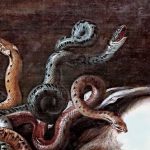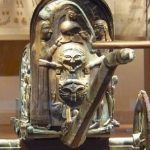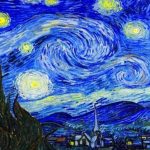 Weird Stuff
Weird Stuff  Weird Stuff
Weird Stuff  Our World
Our World 10 Ways Your Christmas Tree Is More Lit Than You Think
 Movies and TV
Movies and TV The 10 Coolest Stars to Set Sail on The Love Boat
 History
History 10 Things You Didn’t Know About the American National Anthem
 Technology
Technology Top 10 Everyday Tech Buzzwords That Hide a Darker Past
 Humans
Humans 10 Everyday Human Behaviors That Are Actually Survival Instincts
 Animals
Animals 10 Animals That Humiliated and Harmed Historical Leaders
 History
History 10 Most Influential Protests in Modern History
 Creepy
Creepy 10 More Representations of Death from Myth, Legend, and Folktale
 Technology
Technology 10 Scientific Breakthroughs of 2025 That’ll Change Everything
 Weird Stuff
Weird Stuff Ten Bizarre Facts About The Doge Meme
 Our World
Our World 10 Ways Your Christmas Tree Is More Lit Than You Think
 Movies and TV
Movies and TV The 10 Coolest Stars to Set Sail on The Love Boat
Who's Behind Listverse?

Jamie Frater
Head Editor
Jamie founded Listverse due to an insatiable desire to share fascinating, obscure, and bizarre facts. He has been a guest speaker on numerous national radio and television stations and is a five time published author.
More About Us History
History 10 Things You Didn’t Know About the American National Anthem
 Technology
Technology Top 10 Everyday Tech Buzzwords That Hide a Darker Past
 Humans
Humans 10 Everyday Human Behaviors That Are Actually Survival Instincts
 Animals
Animals 10 Animals That Humiliated and Harmed Historical Leaders
 History
History 10 Most Influential Protests in Modern History
 Creepy
Creepy 10 More Representations of Death from Myth, Legend, and Folktale
 Technology
Technology 10 Scientific Breakthroughs of 2025 That’ll Change Everything
10 Famous Artworks That Are Not What They Appear
Art is very personal to the artist; they paint their feelings, hopes, and dreams on the canvas, then stand back and hope the viewers get it. Sometimes we do, and sometimes we don’t. Many paintings carry contrary messages, which doesn’t make the process any easier. Without the necessary context, viewers see the image and, naturally, take it at face value.
It can be hard to distinguish these types of paintings from the rest. Even a seemingly “simple” still-life can be ripe with intricate details and hidden meanings. Similarly, some of the most famous artworks in history contain at least one aspect that the majority of viewers have missed. Does it always make a difference? Not necessarily. But it is usually pretty interesting. Keep reading for 10 famous artworks that aren’t quite what they appear.
Related: Top 10 Famous Paintings That Inspired Horror Moviemakers
10 Self-Portrait with Bandaged Ear (1889) by Vincent Van Gogh
Among history’s most famous paintings is Vincent Van Gogh’s Self-Portrait with Bandaged Ear. The artwork is best known for being painted soon after the artist cut off his ear. A popular theory is that it happened after he drank too much of the hallucinogenic substance absinthe, but that isn’t the entire story.
Fellow artist Paul Gauguin came to live and work alongside Van Gogh in his small yellow house in the south of France. Despite a promising start, their relationship grew tumultuous and strained. When Van Gogh suspected Gauguin was planning on leaving, and Gauguin confirmed it, Van Gogh didn’t take the news very well.
According to Gauguin, Van Gogh “charged at him” threateningly with a “razor in hand.” Later that night, Van Gogh used the same blade to remove his ear. Initially, Van Gogh appeared dead, with blood covering the bed and most of his home. Gauguin confirmed he was alive but told authorities to tell Van Gogh he had returned to Paris. Van Gogh painted the self-portrait as an assurance that he was sane, resting, and fully cooperating with his doctors’ orders- such as keeping warm with a coat and hat.[1]
9 Two Tahitian Women (1899) by Paul Gauguin
Speaking of Gauguin, once the Parisian artist left the yellow house, he grew to become an artist who many claim was “more important than Van Gogh.” Two Tahitian Women is one of several Gauguin paintings that feature Indigenous women portrayed as the ideal “Tahitian Eve.” Despite its innocent appearance- the painting holds dark secrets. The women were later revealed to be more than the artist’s models. They were also his sex slaves.
When Gauguin moved to the South Pacific islands of Tahiti and Hiva Oa, he took three native brides—ages 13, 14, and 14. Claiming he was “quitting decadent Paris for a purer life in a fecund South Seas paradise,” he infected his young wives, and countless others, with syphilis in the home he christened La Maison du Jouir (“the House of Orgasm”). Cracks in his character appeared earlier when he left his wife and five children to move in with Van Gogh for those nine arduous months. The punishment for his wrongdoings? A posthumous lack of exposure.[2]
8 The Scream (1893) by Edvard Munch
Iconic to the level of having its own emoji, Edvard Munch’s The Scream is not quite what it seems. The famed Expressionist artist provided some context regarding his inspiration in a diary entry dated January 22, 1892:
“I was walking along the road with two friends. The sun went down – I felt a gust of melancholy – suddenly the sky turned a bloody red. I stopped, leaned against the railing, tired to death as the flaming skies hung like blood and sword over the blue-black fjord and the city. My friends went on – I stood there trembling with anxiety – and I felt a vast infinite scream through nature.”
His words have led many to theorize that the figure in the painting represents Munch himself. But art historians claim the figure is reminiscent of a Peruvian mummy that Munch saw at the World’s Fair in Paris in 1889.[3]
7 Death and the Child (1889) by Edvard Munch
The Scream isn’t the only painting by Norwegian artist Edvard Munch that contains more than meets the eye. His painting Death and the Child depicts a young girl standing in front of the bed of her recently deceased mother.
Munch’s entire family, save for his devout father, died of a disease when he was a young boy. His father taught him their deaths were “divine retribution for their misdeeds,” a lesson that heavily influenced Munch throughout childhood and early adulthood. The Death and the Child represents the early tragedy and silent grief he suffered, as seen in the girl’s disturbed expression. At the same time, her eyes portray a faraway expression that suggests that she has checked out from reality.
There is also talk that the painting is haunted. Many of its previous owners reported strange supernatural experiences after bringing Death and the Child into their homes. These included claims that the young girls’ eyes would track them wherever they went and the mother’s bed sheets audibly rustled whenever they went near the artwork.[4]
6 The Love Letter’s Replica (1887) by Richard King
Despite being a replica of Love Letters by Charles Trevor Garland (1885-1906), something about Richard King’s painting sets it apart from its predecessor. Best known for being displayed in the Driskill Hotel in Austin, Texas, King’s painting was purchased to serve as a memorial for Samantha Houston, a five-year-old girl who fell to her death on the main stairs while chasing her toy ball. (Rumor has it the subject in the painting bears a striking resemblance to young Samantha).
Guests have reported strange experiences since the painting took up residence on the fifth floor. They described unexplained bouts of dizziness, nausea, and the alarming sensation of being lifted off the ground. Some hotel guests claimed the painting’s subject tried to communicate with them because they noticed her expression change whenever they looked away. Samantha’s ghost has even rattled the doorknob of the Yellow Rose apartment, which is located close to the painting.[5]
5 The Ghost of a Flea (1819–20) by William Blake
The Ghost of a Flea by London-born artist, engraver, and poet William Blake contrasts with the majority of his artwork that brought him fame, which mainly consists of heavenly forms. Blake’s inspiration for these “illumined” works were visions he had since the age of four when he claimed to have seen God’s head appear through the window of his family home.
He also saw angels occupying the neighboring trees with “bright angelic wings bespangling every bough like stars.” The vision followed him through adolescence. By adulthood, these types of visions were commonplace for Blake. As a result, many of his contemporaries thought he was mad.
Inspiration for The Ghost of a Flea came from a different type of vision. John Varley, a fellow artist and close friend of Blake, explained in his Treatise on Zodiacal Physiognomy that the painting was based on a spiritual vision of a ghost and a flea. As Blake was drawing the spirit, it told him that “all fleas were inhabited by the souls of men who were ‘by nature bloodthirsty to excess.’” The creature, a terrifying mix of human and beast, is intended to convey a human character deformed by animalistic traits.[6]
4 The Sistine Chapel (1508–1512) by Michelangelo
One of the most famous artworks in history, Michelangelo’s painting on the ceiling of the Sistine Chapel, contains some surprisingly scientific secrets. In “The Creation Scene,” as God gives Adam his first spark of life, God is depicted with a reddish-brown cloak flowing behind Him and His angels, which happens to form the same shape as a human brain.
John Hopkins researchers reported a similar anatomical addition in “Separation from Light and Darkness,” where they believe Michelangelo painted a brain stem and spinal cord into the underside of God’s neck. Considering Michelangelo was an accomplished artist, sculptor, and anatomist, these are typically considered to be covert protests of the church’s attitude towards science and discovery.
Also present in the famed artwork is an angel with an attitude who appears to pull “the fig,” an old-fashioned snarky hand gesture, at the prophet Zechariah. Zechariah bears an uncanny resemblance to Pope Julius II, who commissioned the painting. He was disliked by many- including Michelangelo.[7]
3 Flower Still Life (1726) by Rachel Ruysch
Many consider still-life painter Rachel Ruysch of the Dutch Golden Age as the greatest flower painter of her time. Internationally recognized for her “elaborate and microscopically detailed” renderings, Ruysch often painted unique combinations of flowers that bloomed during different seasons. That way, they could never be mistaken for the real thing.
“Every Ruysch bouquet was carefully crafted to reveal a breadth of knowledge, whether that be conveyed in the specific types of flowers or their state of bloom.”
In Flower Still Life, poppies, snapdragons, roses, carnations, hollyhocks, marigolds, morning glories, and a single red and white flamed tulip spill out of the vase and fill the entire space. Some are in full bloom, others wilt and die, and insects have eaten holes in the leaves.
Scholars claim the various states of the flowers pictured represent vanitas, a moral message that “beauty fades and all living things die.” They suggest Ruysch’s painting intended to warn her wealthy Dutch consumers not to become too attached to their material possessions and worldly pleasures because eternal salvation only comes through God.[8]
2 El Autobus (1929) by Frida Kahlo
Frida Kahlo’s El Autobus may look like a straightforward representation of the different classes of Mexican society sitting side-by-side on a wooden bench at a bus stop. But, it has a deeper, hidden meaning. Despite her almost cult-like following, not everyone knows that the Mexican artist was involved in a bus accident four years before painting the artwork, in which an iron handrail became impaled through her pelvis.
As Kahlo later described, it felt like “the way a sword pierces a bull.” The handrail fractured her pelvis, piercing her abdomen and uterus. Her spine broke in three places, her right leg in 11 places, her shoulder dislocated, and her collarbone broke. It was later discovered that three additional vertebrae were broken as well.
Kahlo’s recovery was long and uncomfortable. She spent most of it in bed in a plaster cast. Lingering pain from her injuries led her to abandon her dream of becoming a medical illustrator. It’s also been said that the accident left her unable to have children. El Autobus depicts Kahlo and a group of passengers waiting for the bus on that tragic day. The woman to the right appears to be Kahlo.[9]
1 32 Campbell’s Soup Cans (1962) by Andy Warhol
Few artworks are less recognizable than Andy Warhol’s 32 Campbell’s Soup Cans. Featuring the 32 varieties of Campbell’s soup, the series was Warhol’s favorite. According to the famed pop artist:
“I should have just done the Campbell’s Soups and kept on doing them… because everybody only does one painting anyway.”
An instant sensation when exhibited at the Los Angeles Ferus Gallery, not everyone is aware that they weren’t originally set up to stay together. Gallery owner Irving Blum sold five panels before realizing he’d make a more significant sale as a set. Blum had to track down the sold pieces and buy them back, including one from actor Dennis Hopper. He then purchased the entire series from Warhol for a modest $3,000.
Despite being his favorite artwork, there is a rumor that Warhol hated Campbell’s soup. In his book Pop, biographer Tony Scherman claimed that Warhol ate soup daily as a child because it was all his family could afford. A fact that, if true, paints a significantly different picture.[10]








